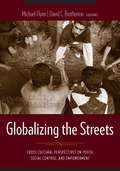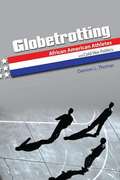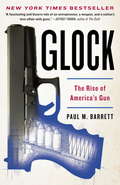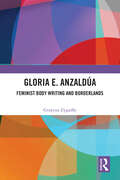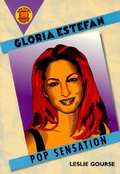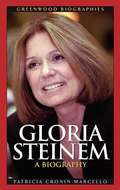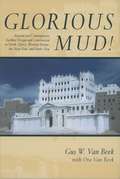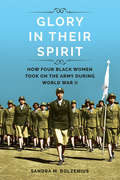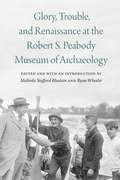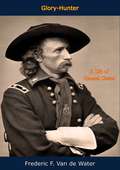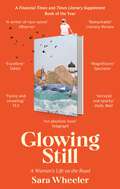- Table View
- List View
Globalizing the Streets: Cross-Cultural Perspectives on Youth, Social Control, and Empowerment
by Flynn Michael David C. Brotherton Eds.Not since the 1960s have the activities of resistance among lower- and working-class youth caused such anxiety in the international community. Yet today the dispossessed are responding to the challenges of globalization and its methods of social control. The contributors to this volume examine the struggle for identity and interdependence of these youth, their clashes with law enforcement and criminal codes, their fight for social, political, and cultural capital, and their efforts to achieve recognition and empowerment. Essays adopt the vantage point of those whose struggle for social solidarity, self-respect, and survival in criminalized or marginalized spaces. In doing so, they contextualize and humanize the seemingly senseless actions of these youths, who make visible the class contradictions, social exclusion, and rituals of psychological humiliation that permeate their everyday lives.
Globetrotting or Global Citizenship?
by Robert Huish Rebecca TiessenGlobetrotting or Global Citizenship? explores the broad range of international experiential learning options available to Canadian students, as well as the opportunities and the ethical dilemmas that come with them. Combining practical advice with critical examinations of international experiential learning, this essay collection is designed to help the reader to move beyond photo-ops and travel opportunities and towards striving for a deeper global citizenship.Globetrotting or Global Citizenship? is a valuable guide for students considering going abroad for experiential learning and a useful resource for those returning from such programs, as well as instructors and administrators facilitating pre-departure and return orientation sessions. Anyone taking part in international volunteering will find the reflections and analysis provided here an excellent starting point for understanding the potential impact of their time abroad.
Globetrotting: African American Athletes and Cold War Politics (Sport and Society)
by Damion L. ThomasThroughout the Cold War, the Soviet Union deplored the treatment of African Americans by the U.S. government as proof of hypocrisy in the American promises of freedom and equality. This probing history examines government attempts to manipulate international perceptions of U.S. race relations during the Cold War by sending African American athletes abroad on goodwill tours and in international competitions as cultural ambassadors and visible symbols of American values. Damion L. Thomas follows the State Department's efforts from 1945 to 1968 to showcase prosperous African American athletes including Jackie Robinson, Jesse Owens, and the Harlem Globetrotters as the preeminent citizens of the African Diaspora, rather than as victims of racial oppression. With athletes in baseball, track and field, and basketball, the government relied on figures whose fame carried the desired message to countries where English was little understood. However, eventually African American athletes began to provide counter-narratives to State Department claims of American exceptionalism, most notably with Tommie Smith and John Carlos's famous black power salute at the 1968 Mexico City Olympics. Exploring the geopolitical significance of racial integration in sports during the early days of the Cold War, this book looks at the Eisenhower and Kennedy administrations' attempts to utilize sport to overcome hostile international responses to the violent repression of the civil rights movement in the United States. Highlighting how African American athletes responded to significant milestones in American racial justice such as the 1954 Brown v. Board of Education decision and the passage of the 1964 Civil Rights Act, Thomas surveys the shifting political landscape during this period as African American athletes increasingly resisted being used in State Department propaganda and began to use sports to challenge continued oppression.
Globocnik's Men in Italy, 1943–45: Abteilung R and the SS-Wachmannschaften of the Operationszone Adriatisches Küstenland
by Stefano Di Giusto Tommaso ChiussiThe history and activities of the notorious Nazi unit Abteilung R in Italy
Glocalized Security: Domestic and External Issues in International Security
by Abu Bakarr BahWhat forces drive violent conflicts, and whose interests are protected by military involvement? In those conflicts, how do domestic factors fuse with external dynamics, and what issues spell the difference between successful and failed intervention?Enter Glocalized Security—a concept that argues that this fusion of domestic and external matters produces new war dynamics which require both substantial domestic reforms and realignment of external interests to achieve sustainable peace. In this edited collection, contributors use this concept to examine grievances and interests in and around war-torn countries. Combining a variety of disciplines, from sociology and political science to peace studies and public policy and administration, these case studies draw from over three decades of international military interventions around the world, including Afghanistan, Turkey, Somalia, Iraq, Nigeria, and Nepal. Analyzing the intersectional relationship of the local and global, Glocalized Security provides new insights into the problems of international security and why international military interventions often fail to ensure peace and security in conflict zones where these factors have morphed into terrorism warfare or zones of national interest among major world and regional powers.By focusing on ethnicity, religion, poverty, governance, and the other most common motivators of violent conflicts, Glocalized Security provides a crucial conceptual basis for understanding international relations in the twenty-first century.
Glock: The Rise of America's Gun
by Paul M. BarrettBased on fifteen years of research, Glock is the riveting story of the weapon that has become known as America's gun. Today the Glock pistol has been embraced by two-thirds of all U.S. police departments, glamorized in countless Hollywood movies, and featured as a ubiquitous presence on prime-time TV. It has been rhapsodized by hip-hop artists, and coveted by cops and crooks alike. Created in 1982 by Gaston Glock, an obscure Austrian curtain-rod manufacturer, and swiftly adopted by the Austrian army, the Glock pistol, with its lightweight plastic frame and large-capacity spring-action magazine, arrived in America at a fortuitous time. Law enforcement agencies had concluded that their agents and officers, armed with standard six-round revolvers, were getting "outgunned" by drug dealers with semi-automatic pistols. They needed a new gun. When Karl Water, a firearm salesman based in the U.S. first saw a Glock in 1984, his reaction was, "Jeez, that's ugly." But the advantages of the pistol soon became apparent. The standard semi-automatic Glock could fire as many as 17 bullets from its magazine without reloading (one equipped with an extended thirty-three cartridge magazine was used in Tucson to shoot Gabrielle Giffords and 19 others). It was built with only 36 parts that were interchangeable with those of other models. You could drop it underwater, toss it from a helicopter, or leave it out in the snow, and it would still fire. It was reliable, accurate, lightweight, and cheaper to produce than Smith and Wesson's revolver. Made in part of hardened plastic, it was even rumored (incorrectly) to be invisible to airport security screening. Filled with corporate intrigue, political maneuvering, Hollywood glitz, bloody shoot-outs--and an attempt on Gaston Glock's life by a former lieutenant--Glock is at once the inside account of how Glock the company went about marketing its pistol to police agencies and later the public, as well as a compelling chronicle of the evolution of gun culture in America.
Gloria Anzaldúa’s Hemispheric Performativity: Pieces, Shuffles, Layers (Literatures of the Americas)
by Romana RadlwimmerThis Palgrave Pivot offers new insights into leading Chicana writer Gloria Anzaldúa, investigating the dynamic composition of her texts, and situating her work in a larger hemispheric tendency of performativity emerging at the turn of the millennium. Presenting Anzaldúa as a quintessential figure of feminist and decolonial theory-making in the Americas, this book argues that the Chicana writer articulated her notions on fluctuations through “performative concepts” which did not respect the borders of single texts or editions, but organically grew through them. The offered close readings of Anzaldúa’s published works, drafts, and archive material demonstrate the constant changes and intertwined phases of her literary and conceptual production.
Gloria E. Anzaldúa: Feminist Body Writing and Borderlands
by Grażyna ZygadłoGloria E. Anzaldúa is a crucial figure in contemporary border and women’s studies. When in 1987 she published her groundbreaking book Borderlands/La Frontera: The New Mestiza, she became one of the most often quoted writers of the US–Mexico border, but she remains relatively little known outside Americas. In one of the first monographs written on her work, Grażna Zygadło introduces Anzaldúa’s work and outlines her feminist revisionist thinking to new audiences, especially in Europe. The author defines these borderlands as areas where numerous systems of power, exploitation, and oppression intersect – capitalism, patriarchy, racism, and white man’s supremacy. She also concentrates on the innovative philosophy of women’s writing from the body that Anzaldúa has propagated and on her formative role in the women of color feminism. Zygadło also works to expand Anzaldúa’s borderland thinking by applying it to the recent issues related to migration crisis and border problems in the European Union – namely the contradictory treatment of refugees at the Polish eastern border. Gloria E. Anzaldúa is situated at the intersection of various disciplines, in particular, American cultural studies, feminist criticism, and Latin American postcolonial studies, and is a valuable source of knowledge about Anzaldúa’s ideas for undergraduate and graduate students.
Gloria Estefan: Pop Sensation
by Leslie GoursePresents a biography of the Cuban-born singer and composer.
Gloria Steinem: A Biography
by Patricia Cronin MarcelloGloria Steinem represents second-wave American feminism. This new biography recounts her truly fascinating life, one that was remarkable even prior to her association with the feminist movement.
Gloria Steinem: Her Passions, Politics, and Mystique
by Sydney L. SternGIoria Steinem is America's most famous feminist. An icon of modern feminism, Steinem is known to the world as a celebrity, leader, and writer. When her name appears in the media, no explanation is necessary -- the name is the message.
Glorious Mud!: Ancient and Contemporary Earthen Design and Construction in North Africa, Western Europe, the Near East, and Southwest Asia (Smithsonian Contributions to Knowledge)
by Ora Van Beek Gus W. Van BeekInvented about 13,000 years ago, mud architecture has since been one of the most common, economical, useful, and widespread forms of building. It has been--and is still being--used for grand palaces and temples as well as simple shops and homes. Research conducted over the last several decades has enabled archaeologists and architects to understand how now-ruined, ancient mud structures were originally built. Gus and Ora Van Beek describe mud-construction techniques from Southwest Asia, the Near East, North Africa, Europe, and the United States, paying specific attention to problems involving foundations, wall and roof construction, cooling and heating, water erosion, and earthquake damage. Glorious Mud! is not only the definitive reference work on one of the world's most important forms of architecture but also a powerful study of the human past.
Glory and Hope: Inaugural Speech May 10, 1994
by Nelson MandelaSummary: "Glory and Hope" By Nelson Mandela "Glory and Hope" was Nelson Mandela's 1994 inaugural speech as the first democratically elected State President of South Africa. At the time, South Africa was in a rough transition from a system of Apartheid with segregation of people based on race and class divisions to a system with renewed hope for equality to all of their citizens. As the first democratically elected State President of South Africa, Nelson Mandela planned to ease the transition, giving the Africans a sense of pride and security; this speech is the first example of his effort. Reading this speech, the reader encounters lines that tell of pride, passion, and devotion. They realize that Nelson Mandela wrote the speech with his heart rather than with his mind. After tough times, Mandela is not ashamed of his land and believes that with hard work and patience from the citizens of South Africa, they can "reinforce humanity's belief in justice, strengthen its confidence in the nobility of the human soul and sustain all hopes of a glorious life for all,"(Glory and Hope by Nelson Mandela).
Glory in Their Spirit: How Four Black Women Took On the Army during World War II (Women in American History)
by Sandra M BolzeniusBefore Rosa Parks and the March on Washington, four African American women risked their careers and freedom to defy the United States Army over segregation. Women Army Corps (WAC) privates Mary Green, Anna Morrison, Johnnie Murphy, and Alice Young enlisted to serve their country, improve their lives, and claim the privileges of citizenship long denied them. Promised a chance at training and skilled positions, they saw white WACs assigned to those better jobs and found themselves relegated to work as orderlies. In 1945, their strike alongside fifty other WACs captured the nation's attention and ignited passionate debates on racism, women in the military, and patriotism. Glory in Their Spirit presents the powerful story of their persistence and the public uproar that ensued. Newspapers chose sides. Civil rights activists coalesced to wield a new power. The military, meanwhile, found itself increasingly unable to justify its policies. In the end, Green, Morrison, Murphy, and Young chose court-martial over a return to menial duties. But their courage pushed the segregated military to the breaking point ”and helped steer one of American's most powerful institutions onto a new road toward progress and justice.
Glory, Trouble, and Renaissance at the Robert S. Peabody Museum of Archaeology (Critical Studies in the History of Anthropology)
by Malinda Stafford Blustain Ryan WheelerGlory, Trouble, and Renaissance at the Robert S. Peabody Museum of Archaeology chronicles the seminal contributions, tumultuous history, and recent renaissance of the Robert S. Peabody Museum of Archaeology (RSPM). The only archaeology museum that is part of an American high school, it also did cutting-edge research from the 1930s through the 1970s, ultimately returning to its core mission of teaching and learning in the twenty-first century. Essays explore the early history and notable contributions of the museum’s directors and curators, including a tour de force chapter by James Richardson and J. M. Adovasio that interweaves the history of research at the museum with the intriguing story of the peopling of the Americas. Other chapters tackle the challenges of the 1990s, including shrinking financial resources, the Native American Graves Protection and Repatriation Act and relationships with American Indian tribes, and the need to revisit the original mission of the museum, namely, to educate high school students. Like many cultural institutions, the RSPM has faced a host of challenges throughout its history. The contributors to this book describe the creative responses to those challenges and the reinvention of a museum with an unusual past, present, and future.
Glory-Hunter: A Life of General Custer
by Frederic F. Van De WaterGeorge Armstrong Custer (1839-1876) was a United States Army officer and cavalry commander in the American Civil War and the American Indian Wars. He worked closely with General McClellan and the future General Alfred Pleasonton, who both recognized his qualities as a cavalry leader, and he was brevetted brigadier general of Volunteers at age 23. At Gettysburg, he commanded the Michigan Cavalry Brigade, and defeated Jeb Stuart’s assault on Cemetery Ridge, while greatly outnumbered. In 1864, Custer served in the Overland Campaign and in Sheridan’s army in the Shenandoah Valley, defeating Jubal Early at Cedar Creek. His division blocked Lee’s final retreat and received the first flag of truce from the Confederates, Custer being present at Lee’s surrender to U.S. Grant at Appomattox.After the war, Custer was appointed a lieutenant colonel in the Regular Army, and sent west to fight in the Indian Wars. On June 25, 1876, while leading the 7th Cavalry at the Battle of the Little Bighorn in Montana Territory against a coalition of Native American tribes, he was killed along with over one third of his command during an action later romanticized as “Custer’s Last Stand”.“Frederic F. Van de Water has written the Custer book to end all Custer books....[It is] based upon profound research...[and a] thorough understanding of the motivations which shaped Custer’s meteoric career.”—Books.“Mr. Van de Water has accumulated evidence until it can hardly be questioned. There is enough of it to damn the man as hard, cruel, and irresponsible....At any rate, the story has an epic movement, and at last is heart-stirring and somberly beautiful.”—New York Times.“General Custer was a tangle of contradictions. His wife ‘enshrined her husband in the folklore of America.’ Now Mr. Van de Water, without fear or favor, gives us a complete and unsparing analysis of the man.”—William Rose Benét, Saturday Review of Literature.
Glossar der Vulnerabilität
by Jörg Zirfas Markus DederichDieses Glossar unternimmt den ersten Versuch, das semantische Feld des Begriffs ‚Vulnerabilität‘ einzugrenzen und die mit ihm verbundenen heterogenen Phänomene in ihren Überlappungen und Wechselwirkungen kenntlich zu machen. Das Glossar ist dabei an einem anthropologischen, phänomenologischen und pragmatischen Verständnis von Vulnerabilität orientiert. Dargestellt und analysiert werden Phänomene, Ursachen und Folgen unterschiedlicher Formen von Vulnerabilität aus unterschiedlichen disziplinären Zugängen. Neben der Vielschichtigkeit und Komplexität und neben den problematischen und positiven Momenten von Vulnerabilität kommen auch pädagogische Möglichkeiten zur Sprache, diese zu bewältigen und zu gestalten.
Glossary of Chinese Islamic Terms
by Jiangping WangThe most comprehensive glossary to date of Hui Muslim terms and the first to fully match the Chinese term (stated in Chinese script and pinyin) to its Arabic or Persian counterpart (stated in Arabic script with Latin transcription).
Glossy: The inside story of Vogue
by Nina-Sophia Miralles'Dame Anna Wintour might be one of the best-known and most successful journalists on the planet. But it wasn't always like that. When she started out on Vogue she was often so miserable she had to phone her husband for help. This is just one of countless fascinating titbits in this zippy story of dizzying fortune, out-of this-world fashion, ingenuity, passion, sex and power.And, this being fashion, some intense bitchiness too. Started as a gossip magazine for snobbish New Yorkers in 1892, Vogue is now one of the most recognisable brands in the world. Spanning London, New York and Paris, this is a high-speed, fun read full of fascinating though not always likeable people.' Daily MailGlossy is a story of more than a magazine. It is a story of passion and power, dizzying fortune and out-of-this-world fashion, of ingenuity and opportunism, frivolity and malice. This is the definitive story of Vogue.Vogue magazine started, like so many great things do, in the spare room of someone's house. But unlike other such makeshift projects that flare up then fizzle away, Vogue burnt itself onto our cultural consciousness. Today, 128 years later, Vogue spans 22 countries, has an international print readership upwards of 12 million and nets over 67 million monthly online users. Uncontested market leader for a century, it is one of the most recognisable brands in the world and a multi-million dollar money-making machine. It is not just a fashion magazine, it is the establishment. But what - and more importantly who - made Vogue such an enduring success?Glossy will answer this question and more by tracing the previously untold history of the magazine, from its inception as a New York gossip rag, to the sleek, corporate behemoth we know now. This will be a biography of Vogue in every sense of the word, taking the reader through three centuries, two world wars, plunging failures and blinding successes, as it charts the story of the magazine and those who ran it.
Glossy: The inside story of Vogue
by Nina-Sophia Miralles'Dame Anna Wintour might be one of the best-known and most successful journalists on the planet. But it wasn't always like that. When she started out on Vogue she was often so miserable she had to phone her husband for help. This is just one of countless fascinating titbits in this zippy story of dizzying fortune, out-of this-world fashion, ingenuity, passion, sex and power.And, this being fashion, some intense bitchiness too. Started as a gossip magazine for snobbish New Yorkers in 1892, Vogue is now one of the most recognisable brands in the world. Spanning London, New York and Paris, this is a high-speed, fun read full of fascinating though not always likeable people.' Daily MailGlossy is a story of more than a magazine. It is a story of passion and power, dizzying fortune and out-of-this-world fashion, of ingenuity and opportunism, frivolity and malice. This is the definitive story of Vogue.Vogue magazine started, like so many great things do, in the spare room of someone's house. But unlike other such makeshift projects that flare up then fizzle away, Vogue burnt itself onto our cultural consciousness. Today, 128 years later, Vogue spans 22 countries, has an international print readership upwards of 12 million and nets over 67 million monthly online users. Uncontested market leader for a century, it is one of the most recognisable brands in the world and a multi-million dollar money-making machine. It is not just a fashion magazine, it is the establishment. But what - and more importantly who - made Vogue such an enduring success?Glossy will answer this question and more by tracing the previously untold history of the magazine, from its inception as a New York gossip rag, to the sleek, corporate behemoth we know now. This will be a biography of Vogue in every sense of the word, taking the reader through three centuries, two world wars, plunging failures and blinding successes, as it charts the story of the magazine and those who ran it.
Glossy: The inside story of Vogue
by Nina-Sophia MirallesGlossy is a story of more than a magazine. It is a story of passion and power, dizzying fortune and out-of-this-world fashion, of ingenuity and opportunism, frivolity and malice. This is the definitive story of Vogue.Vogue magazine started, like so many great things do, in the spare room of someone's house. But unlike other such makeshift projects that flare up then fizzle away, Vogue burnt itself into our cultural consciousness. Today, 125 years later, Vogue spans 22 countries, has an international print readership upwards of 12 million and nets over 67 million monthly online users. Uncontested market leader for a century, it is one of the most recognisable brands in the world and a multi-million dollar money-making machine. It is not just a fashion magazine, it is the establishment. But what - and more importantly who - made Vogue such an enduring success?Glossy will answer this question and more by tracing the previously untold history of the magazine, from its inception as a New York gossip rag, to the sleek, corporate behemoth we know now. This will be a biography of Vogue in every sense of the word, taking the reader through three centuries, two world wars, plunging failures and blinding successes, as it charts the story of the magazine and those who ran it.(P)2020 Quercus Editions Limited
Gloucestershire Folk Tales for Children
by Kirsty Hartsiotis Anthony NansonWhy do giants throw stones? Where does the immortal cat lurk? Who cooks old boots in stews? Why do the fairies guard the wells? Why does a rolling wheel help the sun shine? Dive into these tales from forest, vale and high, high hill and go on a journey that will take you far into the past, deep into other worlds, and through the festivals of the year – all without leaving Gloucestershire! These strange and fabulous tales from all over the county are brought to life by Stroud storytellers Anthony Nanson and Kirsty Hartsiotis.
Glowing Still: A Woman's Life on the Road - 'Funny, furious writing from the queen of intrepid travel' Daily Telegraph
by Sara WheelerBritain's foremost woman travel writer Sara Wheeler records her life of adventure, from the Antarctic to Zanzibar.'Funny, furious writing from the queen of intrepid travel' Daily Telegraph'Magnificent and unusual... Glowing Still is a thoughtful and entertaining meditation on identity, geography and the position of the self in the world' SpectatorSara Wheeler is Britain's foremost woman travel writer. Glowing Still is the story of her travelling life - what is 'important, revealing or funny' - in a notoriously testosterone-laden field. Growing up among blue-collar Conservatives in Bristol where 'we didn't know anyone who wasn't like us', Wheeler knew she needed to get away. In her twenties she began a dramatic escape: Pole to Pole, via Poland. Glowing Still recalls happy days on India's Puri Express; an Antarctic lavatory through which a seal popped up (hot fishy breath!); and the louche life of a Parisian shopgirl. Corralling reindeer with the Sámi in Arctic Sweden and towing her baby on a sledge, a helpful herdsman advised her to put foil down her bra to facilitate nursing.Launching at Nubility, Wheeler voyages, via small children, to the welcoming port of Invisibility (she leaves Immobility for the next volume). As she writes in the introduction, when she set sail 'Role models were scarce in the travel-writing game.' But advancing years usher in unheralded freedoms, and journey's end finds Wheeler at peace among Zanzibar dhows, contemplating our connection with other lives - the irreplaceable value that travel brings - and paying homage to her heroines, among them Martha Gellhorn, the ineffable war correspondent who furnishes Wheeler's epigraph: 'I do not wish to be good. I wish to be hell on wheels, or dead.'
Glowing Still: A Woman's Life on the Road - 'Funny, furious writing from the queen of intrepid travel' Daily Telegraph
by Sara WheelerBritain's foremost woman travel writer Sara Wheeler records her life of adventure, from the Antarctic to Zanzibar.'Funny, furious writing from the queen of intrepid travel' Daily Telegraph'Magnificent and unusual... Glowing Still is a thoughtful and entertaining meditation on identity, geography and the position of the self in the world' SpectatorSara Wheeler is Britain's foremost woman travel writer. Glowing Still is the story of her travelling life - what is 'important, revealing or funny' - in a notoriously testosterone-laden field. Growing up among blue-collar Conservatives in Bristol where 'we didn't know anyone who wasn't like us', Wheeler knew she needed to get away. In her twenties she began a dramatic escape: Pole to Pole, via Poland. Glowing Still recalls happy days on India's Puri Express; an Antarctic lavatory through which a seal popped up (hot fishy breath!); and the louche life of a Parisian shopgirl. Corralling reindeer with the Sámi in Arctic Sweden and towing her baby on a sledge, a helpful herdsman advised her to put foil down her bra to facilitate nursing.Launching at Nubility, Wheeler voyages, via small children, to the welcoming port of Invisibility (she leaves Immobility for the next volume). As she writes in the introduction, when she set sail 'Role models were scarce in the travel-writing game.' But advancing years usher in unheralded freedoms, and journey's end finds Wheeler at peace among Zanzibar dhows, contemplating our connection with other lives - the irreplaceable value that travel brings - and paying homage to her heroines, among them Martha Gellhorn, the ineffable war correspondent who furnishes Wheeler's epigraph: 'I do not wish to be good. I wish to be hell on wheels, or dead.'
Glowing Still: A Woman's Life on the Road - 'Funny, furious writing from the queen of intrepid travel' Daily Telegraph
by Sara WheelerBritain's foremost woman travel writer Sara Wheeler records her life of adventure, from the Antarctic to Zanzibar.'Funny, furious writing from the queen of intrepid travel' Daily Telegraph'Intrepid and sparky, full of canny quips and lightly poetic observations' Mail on Sunday'Magnificent and unusual... Glowing Still is a thoughtful and entertaining meditation on identity, geography and the position of the self in the world' Viv Groskop, SpectatorSara Wheeler is Britain's foremost woman travel writer. Glowing Still is the story of her travelling life - what is 'important, revealing or funny' - in a notoriously testosterone-laden field. Growing up among blue-collar Conservatives in Bristol where 'we didn't know anyone who wasn't like us', Wheeler knew she needed to get away. In her twenties she began a dramatic escape: Pole to Pole, via Poland. Glowing Still recalls happy days on India's Puri Express; an Antarctic lavatory through which a seal popped up (hot fishy breath!); and the louche life of a Parisian shopgirl. Corralling reindeer with the Sámi in Arctic Sweden and towing her baby on a sledge, a helpful herdsman advised her to put foil down her bra to facilitate nursing.Launching at Nubility, Wheeler voyages, via small children, to the welcoming port of Invisibility (she leaves Immobility for the next volume). As she writes in the introduction, when she set sail 'Role models were scarce in the travel-writing game.' But advancing years usher in unheralded freedoms, and journey's end finds Wheeler at peace among Zanzibar dhows, contemplating our connection with other lives - the irreplaceable value that travel brings - and paying homage to her heroines, among them Martha Gellhorn, the ineffable war correspondent who furnishes Wheeler's epigraph: 'I do not wish to be good. I wish to be hell on wheels, or dead.'
